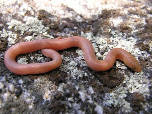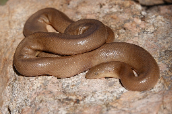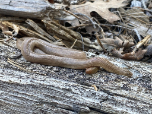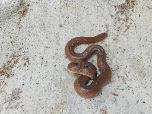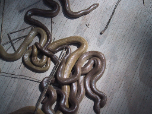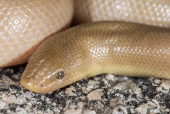Southern Rubber Boa (Charina umbratica)
Description: The maximum total length of males in the San Bernardino mountains is about 19.5 inches, and females about 22 inches. Appearance:
A small constrictor with a stout body and smooth shiny small-scaled loose and wrinkled skin which gives the snake a rubbery look and feel. Eyes are small with vertically elliptical pupils. The tail is short and blunt and looks like a head. The top of the head is covered with large scales. Color and Pattern:
Uniform in dorsal color - light brown, dark brown, pink, tan, or olive-green above, and yellow, orange, or cream colored below. There is usually no pattern below, but sometimes there is dark mottling. Young: Young snakes are pink or tan, and some can be brightly-colored.
Habitat: The southern rubber boa is known to typically inhabit areas such woodlands and coniferous forests characterized by their developed soils and great vegetative productivity. These areas are typically moist and may contain accumulated organic debris that are largely-responsible for the moisture levels of inhabited sites. The southern rubber boa makes use of outcrops, loose and developed soils, as well as tree-debris to burrow and seek refuge.
Range: The southern rubber boa is distributed across the San Bernardino and San Jacinto Mountains, at elevations between 4,900 and 7,900 feet. Phylogenetic analyses have conclusively distinguished northern and southern boas and identified an area in Northeastern California containing populations of both subspecies. Some intergrades between northern and southern boas have been located in isolated populations in the Southern Los Padres Ranges.
Found in these States:
CA
Diet: Eats mostly small mammals, birds, and, lizards.
Reproduction: Boas are ovoviviparous – they produce between two and eight young snakes where eggs are hatched within the parent. In April, female boas typically emerge from hibernation under reproductive conditions; mating occurs immediately and persists through May. They give birth between late summer and throughout autumn with a greater majority of young birthed between late August through September.
Status: Listed as Vulnerable in view of the small extent of occurrence (less than 20,000 km2), small number of locations (may not exceed 10), and continuing decline in extent and quality of habitat.
»» Kingdom: Animalia - Animals
»» Phylum: Chordata - Chordates
»» Subphylum: Vertebrata - Vertebrates
»» Class: Reptilia - Reptiles
»» Order: Squamata - Scaled Reptiles
»» Suborder: Serpentes
»» Superfamily: Booidea
»» Family: Boidae - Boas
»» Genus: Charina
»» Species: Charina umbratica - Southern Rubber Boa
»» Subspecies: None
This article uses material from the Wikipedia article "Southern Rubber Boa", which is released under the Creative Commons Attribution-Share-Alike License 3.0. Content may have been omitted from the original, but no content has been changed or extended.
|


